
A pond liner will inevitably need to be installed when creating a pond. Of course, this liner effectively allows a pond to retain water. However, many have wondered what is installed beneath a pond liner. Known as an underlayment, this layer is crucial in constructing a pond.
Underlayment should be installed under a pond liner. Made from geotextile materials, underlayers protect pond liners and prevent stretching when the liner settles in the pond. This protective layer also prevents punctures from sharp objects and root growth, increasing the lifespan of a pond liner.
If you want to know more about the underlayment beneath a pond liner, we’ll break down everything you should know. We’ll discuss the underlayment, whether this is always necessary, and the benefits it provides. Once we’ve done this, we’ll explain what material this underlayment is made from, how it’s installed, and how long it will last.
Pro Tip: If you’re tired of wasting money and making costly mistakes on the koi-keeping hobby or are thinking about buying koi fish but don’t know where to start, I strongly suggest you check out this ebook. I recently read this ebook, and it contains SO much useful information, such as:
- 3 proven steps to identify koi fish diseases
- WARNING: 3 things you should NEVER do when it comes to caring for koi
- When to seek professional help when it comes to looking after your koi
What Should You Put Under A Pond Liner?

When it comes down to constructing a pond, pond liners play an important functional role. A pond liner is a type of impermeable membrane that’s used for the retention of liquid. From giant reservoirs to garden ponds, these liners are widely used.
In fact, many studies have revealed that pond liners effectively reduce the amount of seepage from ponds. When seepage occurs, leaks in your pond can develop. A marked stick can track water levels to determine whether a pond is leaking.
However, you might wonder why a pond liner would be prone to seepage. Ultimately, pond leaks are mainly attributed to mistakes made when constructing the pond. Pond leaks can often be tricky to pinpoint and repair, so proper construction is essential from the beginning.
Pond seepage and leaks are more specifically attributed to the improper construction of the pond’s base. When a pond is created, gravel, sand, and bedrock fractures must be adequately covered. However, is a pond liner enough to adequately cover these areas?
For some dams, a pond liner may be sufficient to retain water. Ultimately, this comes down to the terrain where the pond is constructed. To prevent issues with pond liners from developing, underlayment should be installed beneath your pond liner for better protection.
Underlayers for pond liners are geotextiles that are thicker and more durable than pond liners, which are known to be rather flexible. Installing an underlayer beneath a pond liner will protect the pond liner from being punctured or damaged over time – but is it necessary to install an underlayment?
Do You Need To Install Underlayment Under Pond Liners?
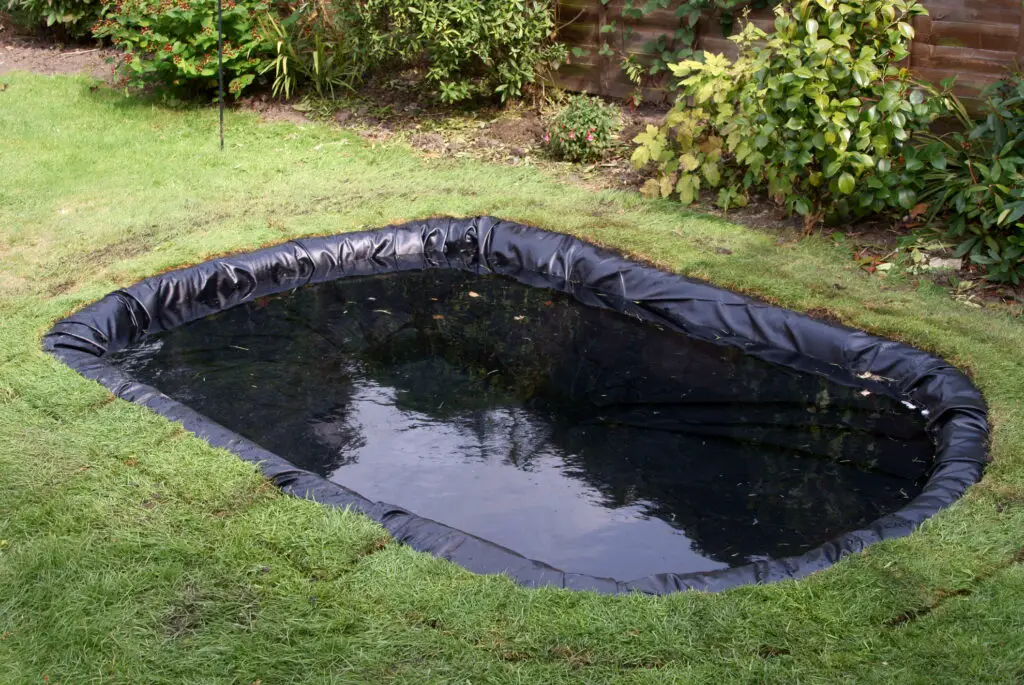
In the above section, we explained that underlayers are installed beneath pond liners. Of course, every pond requires a liner to ensure water does not leak from the pond’s base. However, does every pond require underlayment beneath the pond liner?
As mentioned, pond liners are essential for every pond to ensure water is retained. However, underlayment isn’t always necessary. Ultimately, the effectiveness of a pond liner without an underlayer will depend on the pond’s terrain. Some liners will also be more durable than others. However, the installation of underlayment is widely recommended by professionals.
Due to the nature of pond liners – namely, how and where they are installed – the material needs to be flexible. This allows the pond liner to fit the shape of any pond. However, this flexibility impacts the long-term durability of these liners. When only a pond liner is used, it is common for leaks to develop.
In the first section, we mentioned that pond leaks are generally attributed to the improper construction of a pond’s base. For instance, the floor of a pond needs to be inspected for any sharp objects and voids. Skipping this step can result in a weak pond liner that will develop issues and may need to be prematurely replaced.
However, these leaks often develop because people do not install an underlayment beneath the pond liner. While many do not consider underlayment necessary, it is a crucial step when installing a pond liner. In fact, if you research how to install a liner in your pond, many guides include the installation of an underlayer.
To fully comprehend the importance of this step, you need to know more about the benefits of using an underlayment beneath your pond liner. In fact, there are many benefits to using this specialized layer in constructing your pond.
I have recently written a similar blog post that you might find interesting called: the 10 best thick pond liners
4 Benefits Of Using Underlayment With Pond Liners
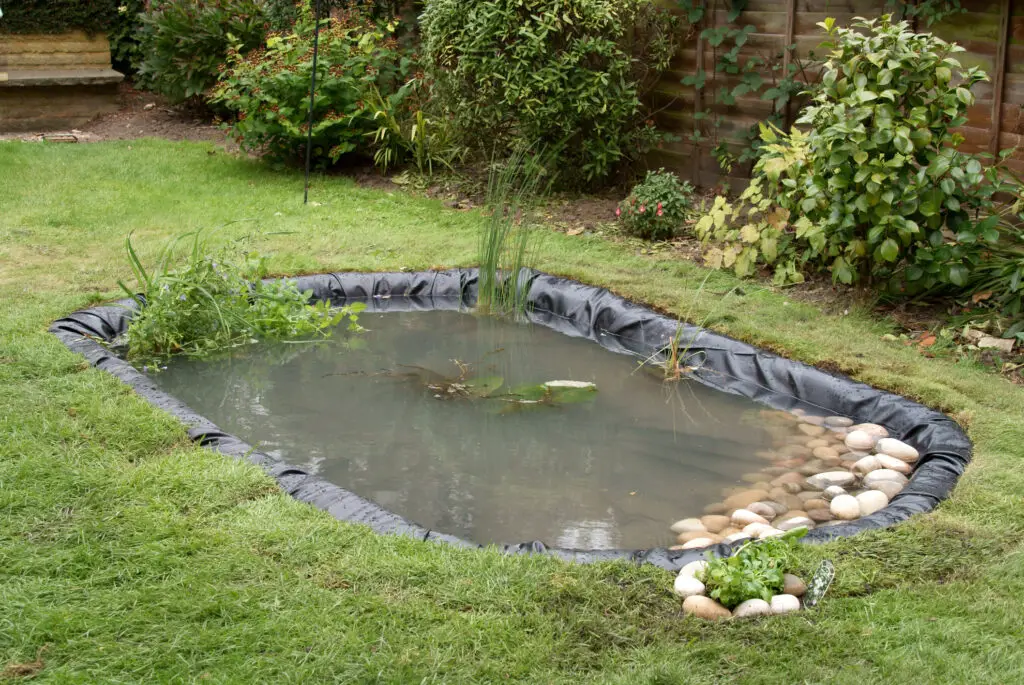
As we mentioned above, there are many benefits to using an underlayment when installing your pond liner. If you’re unsure whether to install this underlayer, understanding the advantages may convince you why this layer is crucial for your pond!
1: Underlayment Prevents Pond Liners From Stretching
The flexibility of pond leaners means that they tend to stretch over time. This stretching results from pond liners settling over time and taking the shape of the pond. Therefore it’s important to try and make a pond’s base as level as possible. Naturally, when pond liners stretch, their effectiveness is significantly reduced. By installing an underlayment, you can prevent your pond liner from stretching over time.
2: Underlayment Covers Sharp Edges
When excavating a pond, the terrain will have many sharp edges and voids. As we discussed, these sharp edges can puncture your pond liner. Any holes in the pond can also contribute to leaks developing. By using an underlayment, you ensure that all rocks and sharp edges are appropriately covered. The following advantage is closely linked to this!
3: Underlayment Prevents Root Growth
With any pond, there’s the threat of root growth from below. While this may be more common with certain soil types and climates, any pond is at risk. When only a liner is used during the construction of the pond, root growth can also result in punctures – even despite your best efforts to ensure there are no sharp edges when the pond is installed. An underlayer effectively prevents this root growth from damaging your pond.
4: Underlayment Increases The Lifespan Of Pond Liners
Essentially, this benefit is a cumulative advantage because it stems from the other benefits. Given that an underlayment provides additional protection for a pond liner, these liners will require fewer repairs and last longer than pond liners without an underlayer.
What Is Pond Underlayment Made Of?
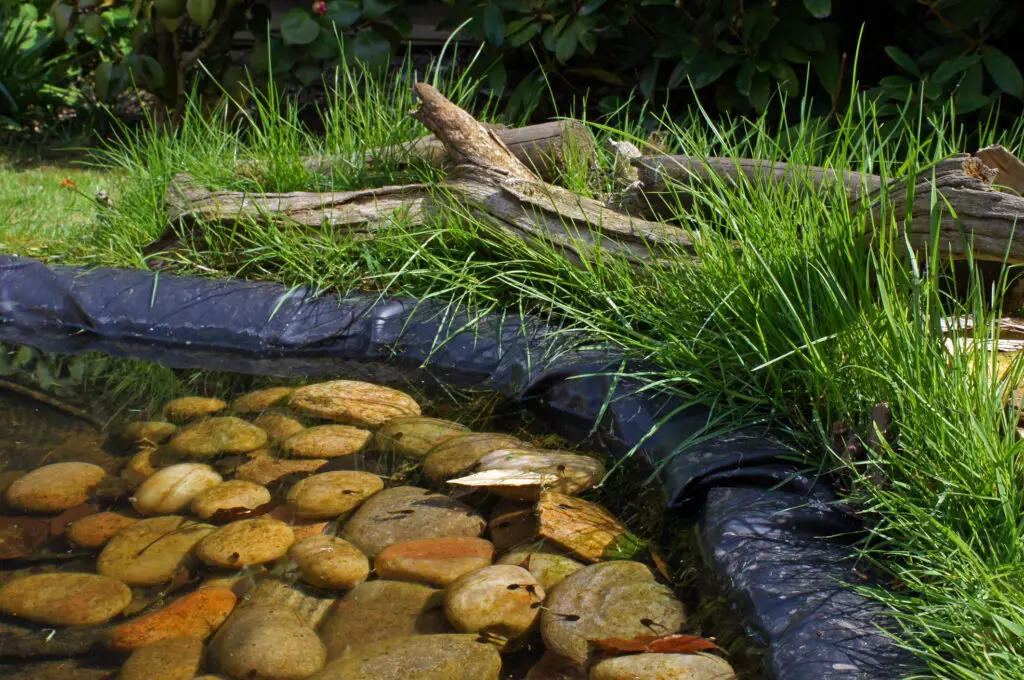
So far, we’ve outlined why pond liners require underlayers. Of course, there are numerous benefits to this extra layer of protection. However, now that we’ve established the importance of an underlayment, you might be wondering about the materials that can be used for this layer.
The type of material that needs to be used for a pond liner’s underlayer is known as a geotextile, a synthetic textile material. A few key properties of geotextiles make them ideal for use in pond liners. Understanding these properties is crucial to choosing a material for your underlayment.
Firstly, geotextiles are permeable textiles, which means that the material allows water to pass through. Secondly, geotextiles are designed to be used in conjunction with soil. This unique design allows geotextiles to separate, reinforce, drain, and protect.
While geotextiles are commonly used in pond liner underlayers, they have various other uses. For instance, these materials are also used in landfills! Many geotextiles are man-made fabrics such as polyester and polypropylene.
In fact, using these man-made textiles provides another benefit. Despite being exposed to the soil for long periods of time, the materials will not rot or break down. Of course, this ensures the long-term effectiveness of your pond liner’s underlayment.
When researching underlayment materials, you’ll find many people recommending using non-geotextile materials, such as old carpets. While certain non-geotextiles may be an inexpensive solution for an underlayer, they will not hold up in the long run.
When materials made from natural fibers are used, such as wool carpets, the fabric will begin to rot and decompose over time. When choosing a material for your underlayment, you should preferably select a man-made geotextile that has the above-discussed characteristics and will not break down when exposed to the earth.
Luckily, there are many geotextile materials that are readily available to purchase today and use as an underlayment. Using a specialized geotextile under your pond liner, you can ensure that the underlayment does what it’s supposed to and protects your pond liner.
Six Steps To Install Underlayment Beneath A Pond Liner
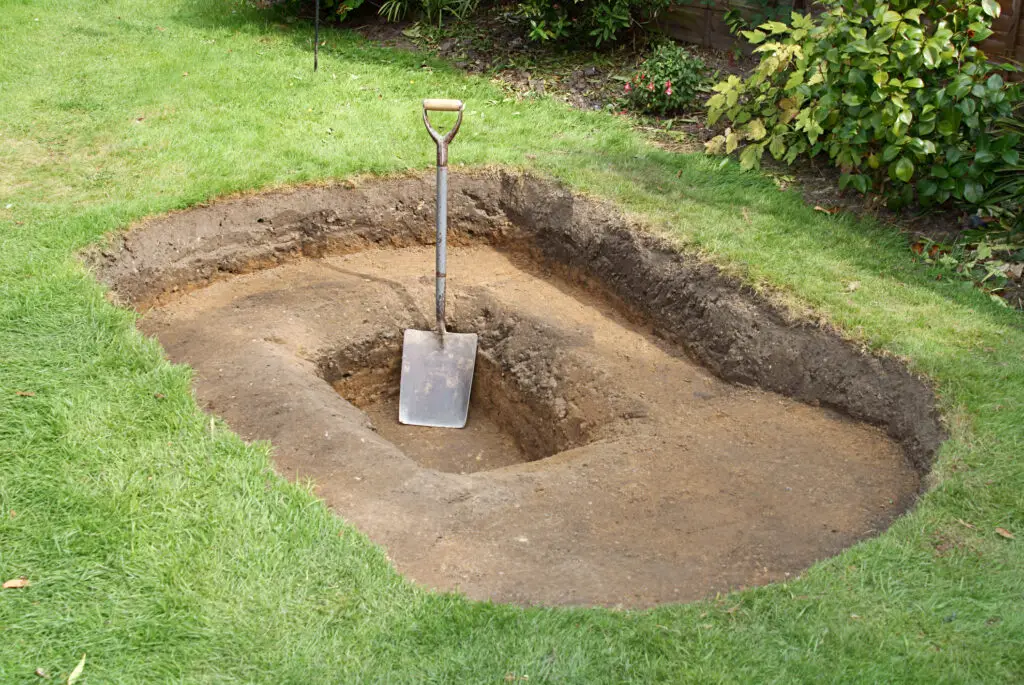
Earlier in this article, we mentioned that the installation of underlayment should form part of the process of installing a pond liner. When issues develop with ponds, particularly seepage, and leaks, it’s usually due to improper construction of the pond’s base. By following the steps, you can ensure that your pond has a solid foundation!
Step One: Inspect The Pond For Sharp Objects
You should ensure the pond base and walls are free of sharp objects before installing your underlayment. When inspecting your bond’s floor and walls, you should inspect for sticks, rocks, and root growth. When a sharp object cannot be removed, it should be covered with a layer of soil or sand to even out the surface.
Step Two: Fill Any Voids In The Pond
When inspecting your pond’s base and walls, you should look for voids. If you locate any holes larger than 1 inch, you must fill them to avoid your pond liner stretching to fill the void. This is often a result of water’s weight when added to the pond. Sand, soil, and dirt can be packed into holes to fill them. Expanding foam can also be used to fill these gaps.
Step Three: Determine How Much Underlayment Is Required
To determine how much underlayment you require, you’ll need to measure your pond. A string or rope can be used to do this. When measuring your pond, you should measure across the longest and widest points. Once you’ve calculated this, you’ll want to factor in between a 10 and 20-inch overhang to be on the safe side.
Step Four: Choose Your Geotextile Underlayment Material
Now that you’ve calculated how much underlayment is required, it’s time to choose a material! As we explained earlier, geotextiles should be used for your underlayment. However, you’ll need to choose a geotextile within your budget. Luckily, there are many options that are readily available today in different sizes. Once you’ve purchased this material, you can install your underlayment.
Step Five: Install Underlayment
When purchasing a geotextile underlayment, you will receive manufacturer instructions regarding the installation. For the best result, you should carefully follow the provided instructions when installing your underlayment. Leftover underlayment can be used as additional protective layers before the pond liner is installed.
Step Six: Continue With Pond Liner Installation
Once you’ve installed your underlayment according to the manufacturer’s instructions, you can continue with the installation of your pond liner. When the previous steps have been correctly followed, your pond liner will be adequately protected against damage – but how long will it last?
If you are planning on building a koi pond, you can check out my posts on pond DIY here:
- How To Build A Large Koi Pond
- How To Build An Indoor Koi Pond
- How To Build A Koi Pond UK
- How To Build A Koi Pond On A Slope
- How To Build A Koi Pond With A Bottom Drain
- How To Build A Koi Pond With Bricks
- How To Make An Above Ground Koi Pond
- How To Build A Mini Pond
- How To Build A Koi Pond Cheap
- How To Build A Small Koi Pond
- How To Build A Koi Pond With Concrete Blocks
- Are Pond Kits Worth It?
- How To Build A Koi Pond With A Waterfall
How Long Do Pond Liners Last?
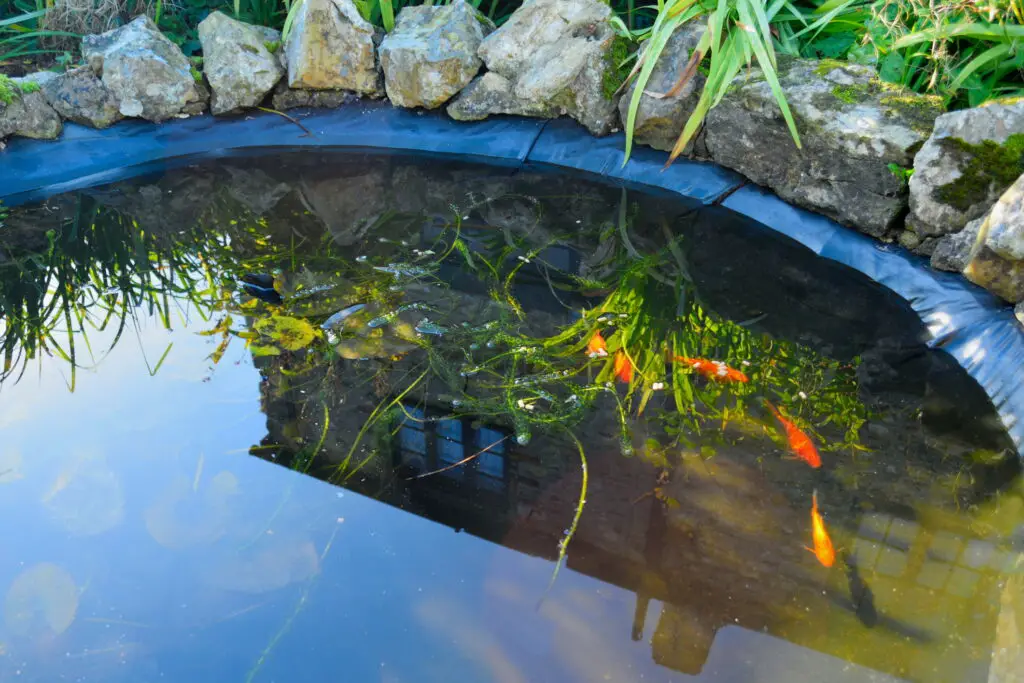
Issues with ponds are often linked to improper construction of the pond. However, when an underlayer is used beneath a pond liner, the liner will be protected and will last longer. However, you may wonder how long the pond liner and underlayment will last.
When properly installed following the appropriate steps, a pond liner and underlayment can last for more than two decades. This is due to the fantastic benefits the underlayer provides. However, without an underlayer, a pool liner may need to be prematurely repaired or replaced due to stretching and punctures.
Conclusion
A pond liner should be installed over a geotextile underlayment. Pond liners are protected by this underlayment, which effectively prevents stretching when the liner settles into the pond’s base. Additionally, this layer prevents punctures from sharp objects and root growth. By installing an underlayment, the lifespan of a pond liner can be significantly increased.
Sources:
https://www.westernliner.com/blog/how-pond-liners-conserve-water/
https://extension.psu.edu/fixing-a-leaking-pond
https://www.everything-ponds.com/installing-a-pond-liner.html
https://www.pondkeeper.co.uk/blog/pond-liner-underlay–why-do-i-need-it

